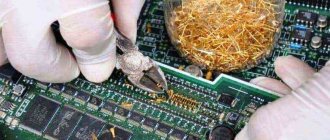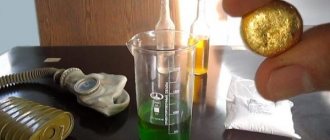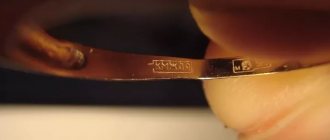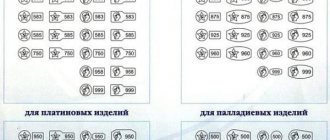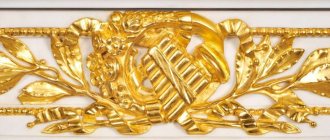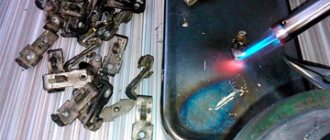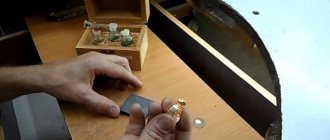Probably few people know that most radio components contain gold in large and small quantities.
Mining gold from such parts is much more efficient than collecting gold from watches or trying to extract gold from gold-plated paint. Gold can be extracted from old electronics in a variety of ways. The question may arise: why are radio components coated with gold and not with some other metal, for example, silver? From a physics perspective, silver is more suitable for radio components: it conducts electricity better and resists electric current less. The answer to the question lies in the chemical properties of metals - in this regard, gold is better, because it is less susceptible to oxidation, and therefore lasts longer.
Parts with gold and the content of precious metal in them
Naturally, not all parts contain a lot of gold. Despite this, some people do not notice the huge amount of gold that they simply throw away. Which parts contain more of this precious metal? To put it into perspective, three computers contain about the same amount of gold as can be mined from two tons of gold ore.
Which parts contain the maximum amount of gold? Some radio components containing this metal are presented in the list:
- Microcircuits. The gold-plated outputs of the chip contain varying amounts of metal. In plastic parts, the gold content is quite low, only 0.5-1.2%; ceramic parts can already contain up to 5% gold.
- Fees. From some boards you can extract an impressive amount of raw materials. For example, most of it in a computer is contained in the motherboard and connectors. Given that computers are becoming cheaper and gold is becoming more expensive on the market, it makes some sense to mine it from a computer. In addition, many people throw away computers without realizing that they contain this valuable metal.
- Semiconductors and connectors. They do not contain much of this metal, but there is not only one connector in a computer.
- Resistors. It is rare in them, because they can use silver or (very rarely) platinum.
You can additionally mine this precious metal from circuit boards and old electronics. In the 70-80s, gold was often used to create many machines and devices. These include:
- military equipment devices;
- computing machines;
- radio tubes and others.
Well, what will come as a surprise to most is that phones also contain it. True, not exactly in phones, but in SIM cards.
Microcircuits containing gold
First of all, it is worth looking for gold in domestic radio components of the Soviet period - in imported ones the content of the precious metal is minimal. In many microcircuits, the gold is hidden under the copper casing. You can find out exactly the content of gold alloy in old microcircuits only by looking at the passport for this or that equipment.
Many microcircuits contain gold.
Gold is also found in round, ceramic, planar DIP microcircuits and transistors, plastic cases, and power transistors. In ALS indicators and diodes. In domestically produced connectors, pins with white or yellow coating of contact parts. In lamellas from boards. In ceramic monolithic capacitors of some brands, tantalum capacitors. In some switches, toggle switches, buttons, resistors. In rotation angle and pressure sensors. TPP and TPR thermocouples, thermal resistance, temperature sensors, strain gauges, pressure sensors. The installation wires have fluoroplastic insulation. In some generator lamps, in printed circuit boards with radioelements.
Much more gold is in Soviet computers. To achieve high performance, it was necessary to use a lot of precious metal. Most of these machines have been scrapped and replaced with modern and powerful ones, but such equipment is still found today and a decent amount of gold can be obtained from it.
List of precious metal content in old computers.
The easiest way to extract gold is from this technique. However, non-working equipment can be handed over to special collection points, which themselves sell it at their discretion and make a profit.
Among such equipment there may be a working one, but it is very expensive if offered to collectors.
Before proceeding directly to gold extraction, it is necessary to disassemble the device.
Methods for extracting gold from radio components
This metal can be extracted in two main ways: by etching in reagents and by electrolysis with iron or lead. Other extraction methods are more expensive or produce lower quality results.
One of them is the etching of precious raw materials from the boards. This method is based on the chemical property of metal - inertness. This method is the simplest because it can be easily done at home. The disadvantages include quite large losses: with the right actions they can reach 10%.
This metal has extremely high inertness, and to etch it, a truly working oxidizing agent is required. For this, an oxidizing agent called “regia vodka” is used.
Aqua regia is a mixture of nitric and hydrochloric acid. For manufacturing, you need to combine nitric and hydrochloric acid in a ratio of 1/3. The resulting liquid will initially be clear, but after settling it will become orange in color and have a strong chlorine odor.
Aqua regia is best used immediately after production or after a short period of time. The reason is that during settling, nitrogen dioxide begins to decompose, and when it decomposes, vodka loses its powerful decomposing abilities.
What is the point of etching precious metal with aqua regia? Answer: gold has an unusually high inertness and does not corrode even in vodka. This happens due to the fact that when this metal is immersed in vodka, a layer of passive silver chloride is formed on it, and it stops the corrosion of gold, while the rest of the boards and radio components quietly dissolve. Once dissolved in the liquid, only a thin film of gold will remain, which can be filtered through some types of fabric. When filtering, it is not recommended to use gauze, as it contains large gaps in the fabric and will not be able to filter the precious metal efficiently.
Another reagent that is also used when filtering precious minerals is nitric acid without impurities. You can check the purity of the acid by uncorking a bottle of liquid. If the acid is truly free of impurities, steam should come out of the bottle.
The procedure for extracting precious metals when etching them with reagents:
- Preparation of reagent and soluble parts. The parts containing gold must be separated from each other as much as possible. This will reduce the loss of valuable metal during etching. We must not forget about safety precautions: solutions can be toxic!
- Placing metal in solution. When dissolving microcircuits, problems may arise: the “legs” of the microcircuits next to the gold may not dissolve. In this case, you can use a magnet and attract the iron “legs”.
- Filtration. The gold powder extracted using the fabric must be melted in a special crucible furnace using sodium tetraborate, or so-called borax. Borax is a white powder that can be obtained from gas welders. They use it as solder on brass.
If it is not possible to get a crucible, then you can use burnt brick. Using a grinder or other tool, you need to make indentations in it, pour a mixture of gold and white borax powder into it, and then melt it.
The method of etching gold is the simplest, but it has two significant disadvantages: firstly, there will be quite large losses, and secondly, the gold will not be pure and contain small impurities (approximately 0.1-1%).
What is refining and how to carry it out?
Refining is a method of extracting precious metal from parts. Microcircuits and other parts of devices are not made of pure gold, because in this case the price of equipment would be truly astronomical. Gold plating is applied to individual parts of the board - sputtering helps achieve the desired result and save costs. For this reason, the presence of Au in the device does not have a special impact on the cost of electronics.
So, having collected all the parts that may contain precious metal, it is necessary to prepare them for the evaporation procedure.
To begin with, the parts are sorted and laid out by size, then solder residues or other elements are removed from their surface, checked with a magnet and sorted into several piles. Those parts of the microcircuits that react to the magnet are placed in one direction, and those that do not give such a reaction are placed in the other.
Sorting will help minimize the cost of reagents and speed up the process of obtaining gold from radio components.
Gold refining
Refining (evaporation) is a procedure that can be carried out at home if you have some reagents and the skill to work with them. In order to separate gold from other metals, you need a solvent. Au is inert, the element does not react with acids and alkalis, but there is an exception to the rule - aqua regia is considered this exception.
Aqua regia is a universal solvent and an integral part of refining. It is a mixture of two acids, which chemists call by this name. To obtain a solvent, you need to mix hydrochloric and nitric acid in a ratio of 1 to 3.
The mixture will have a clear color and a strong odor of chlorine and nitrogen. Over time, the color of the solvent will change - it will acquire an orange tint. You cannot store aqua regia: the longer the mixture sits idle, the faster it loses its properties.
Gold comes into contact with a mixture of acids and begins to dissolve, a process that occurs more slowly compared to other metals. By immersing the parts in a flask or dish, you will notice how gold flakes appear on the surface of the solution. If the flask is heated, the reaction will go faster. Some Au will remain in solution.
When flakes appear on the surface of the solution, action must be taken immediately. To extract gold from aqua regia, pass the solution through a thick cloth. Filtration will help separate Au from other elements. The fabric should be so dense that even small grains of precious metal remain on its surface.
The resulting gold is then washed with water as the dissolution reaction continues. Then it is worth melting the resulting material by heating it in a burner.
Refining is a fascinating procedure, but it has its own nuances; if evaporation is carried out for the first time, then you need to additionally familiarize yourself with information on this topic. The reaction may not take place due to poor quality of the reagents or inept actions of an inexperienced chemist.
At the end of all the actions, there is a chance to hold a piece of gold or a small ingot in your hands. The quality of the metal will depend on human actions. Some people were able to obtain white gold at home using reagents - an alloy of nickel and Au, which may contain platinum.
During the evaporation process you can get gold:
- Of red color.
- Green tint.
In addition to the usual yellow color, you can get Au in an unusual shade. The color of the metal changes due to the presence of other elements in the alloy, which give the gold an unusual color.
Extraction of precious metal by electrolysis
The other main method for extracting gold from parts is electrolysis filtration. It needs to be clarified that in this way you can get gold not from all parts, but only from small ones: SIM cards, boards, connectors, semiconductors, etc. Using electrolysis, it is possible to filter out truly pure gold without impurities (not 99.9%, as in the case of etching). The downside is greater losses of this precious metal than in the previous method.
The essence of electrolysis is that two elements are dipped into sulfuric or hydrochloric acid: the anode and the cathode. The anode will be gold-plated radio components, and the cathode will be a lead or iron plate. After both parts are immersed in acid, the plates are fastened together using copper wire and connected to electricity, after which a current with a density of 0.2-0.8 amperes per square decimeter is applied. Radio components containing gold are immersed there, and particles of the precious metal will be separated from the anode and attracted to the cathode, on which they will settle. When all the gold has passed from the anode to the cathode, the plate with gold can be removed and the gold can be cleaned, as in the case of etching, and the remaining plates can only be thrown away.
Electrolysis is not as simple as refining gold in aqua regia, but it creates perfect gold. If the process is too slow or the gold is purified poorly, you can change the density and current value. It wouldn’t hurt to look for a photo of the diagram on the Internet, since it’s almost impossible to repeat it by ear.
It is possible that after etching gold (less commonly, after electrolysis), the metal becomes white. This happens due to the fact that this precious metal is mixed with other metals contained in radio components. Gold can acquire a wide variety of colors: blue (when alloyed with iron), white (alloyed with palladium), green (alloyed with silver in a ratio of 7:3) and others. You can experiment with mixtures and get new colors.
Problems with the legality of gold mining
In the Russian Federation there is a law on the circulation of valuable metals. The list of illegal metals also includes gold. For this reason, it is impossible to legally sell gold obtained by the methods described above. If the desire to produce gold from radio components and circuit boards appeared in the hope of making a monetary profit, then this idea should be abandoned. But the law does not prohibit producing gold for one’s own purposes or as a hobby.
Mining this precious metal from radio components and circuit boards can bring quite a large amount of it. Of course, it will not be possible to completely extract this valuable raw material from radio components, but with the right actions, you can extract 90% of the gold. You can’t sell it for money, but simply recycle discarded equipment parts and give your wife a new necklace on March 8th. A lot of gold can be mined, for example, from computer motherboards.
In our country in the dashing 90s, the banal way of making money by selling non-ferrous metals was especially popular. It remains relevant for some “hard workers” even now. Although the gold content in electronics and ordinary household appliances is small, it is nevertheless present there, which allows you to make a considerable income with painstaking work.
In what parts can you find gold?
Microcircuits. In them, gold is present in the form of gold-plated leads pressed into plastic or ceramic cases. The mass of gold leads is one third of the mass of the microcircuit. The gold content can vary from one to five percent.
Radio tubes
In them, gold is deposited on a grid located very close to the cathode. This is necessary so that the grid does not become a source of electrons.
Transistors
Gold is placed under conductors and crystals.
Don’t rush to throw away your old equipment - many of its parts contain gold.
Capacitors
Gold-bearing capacitors were used in military radio stations and generators. One capacitor measures up to forty centimeters in height and up to twenty centimeters in width. Such a capacitor contains up to seven grams of gold.
Resistors
Semiconductors, diodes, stabilizers, optocouplers, thyristors.
Connectors
Most older connectors can be gold plated.
